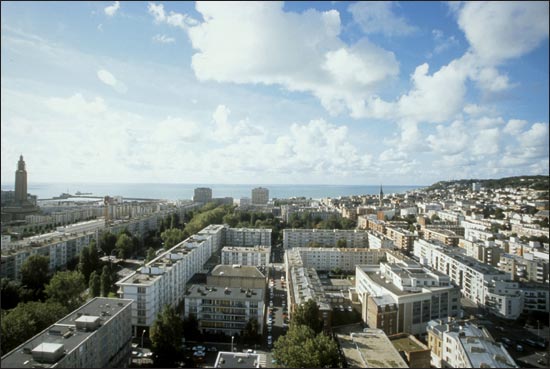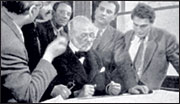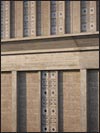Historians and town planners consider the reconstruction of the Havre as one of the most significant developments of the XXth century, a very rich urban and architectural laboratory . On 15 July 2005, the Unesco included Le Havre in the world heritage of mankind. It has joined other extraordinary members of this club that includes such diverse sites as the wild expanse of the Serengeti national park in Eastern Africa, the Pyramids of Egypt, the Acropolis in Athens, Westminster cathedral, the Mesa Verde, as well as the town of Toledo. All are proof of a patrimony that belongs to all of mankind, whatever the territory on which they are located.
The city most destroyed in France
In order to supply the allied troops that were heading East and to be able to use this large port on the northern bank of the Seine, General Crocker ordered a massive attack that turned Le Havre into the most destroyed city in France. On 5 and 6 September 1944, in four hours of «carpet bombing», the Downtown area was totally razed by the Royal Air Force. The city lost all its decision-making centers, its cultural sites, its habitat. It lost its memory as well. In the meantime the Germans destroyed all the port installations. One single terrifying phrase illustrates the feeling of the residents of Le Havre when facing this extension of ruins that covered nearly 2 km up to the coast: "One could see all the way to the sea... " The conflict killed 5 126 residents in the Havre and destroyed 12 500 buildings, leaving 80 000 victims of which 35 000 homeless. It took the city twenty years to come back to life. In May 1945, Auguste Perret, then 71 years old, was named Chief Architect of the reconstruction of Le Havre.
A unique gathering of competences.
Auguste Perret arrived surrounded by 18 architects, former students and disciples, who created the "Atelier de Reconstruction du Havre”. In total one hundred architects worked around him. This reconstruction was to be his masterpiece. He was already considered as one of the major architects of the 20th century, as well as Le Corbusier, Mallet Stevens or Tony Garnier. Le Havre, at the end of a very rich career, gave him the opportunity to put his theories into practice at an unexpected scale. He continued the great French classical tradition in XXth century architecture, and opened the way to modern architecture in a specific register, that of structural classicism, the modern synthesis of two antagonistic currents of the XIXth century: neo-gothic and neo-classic. This unifying doctrine was applied for the first time at the scale of a city in Le Havre, and it determined its general morphology. When Perret died on 25 February 1954 most of the blocks were reconstructed but the two most important buildings, the Hôtel de Ville and the church of Saint-Joseph were only delivered some years following his death.
My concrete can stand on its own...
With Auguste Perret, one can refer to a true "ennoblement of concrete", the material he gave life to. Concrete, as he saw it –that is treated, decorated and coloured – and of which he said that it could “stand on its own”, reacts differently to light, while restoring the tone of the original stone. The original architecture Perret sought, with its antique style columns and its oriental inspired claustra, open Le Havre to the sea. The light of the sky in Le Havre, that the Impressionist so appreciated, gives a strong feeling of space. Added to this we have the brightness of the architectural choice, the composition and structuring of the public spaces, avenues, boulevards and squares, as well as the blocks, the setting and the monumental character of major areas such as the place de l'Hôtel de Ville, Porte Océane, the Front de Mer Sud or the Bassin du Commerce.
New interest has aroused over the last years in the Perret School and we can rediscover the part it played in the birth of modern architecture. It has had a deep influence on the architectural scene and the urban landscape of various other cities. Now universally used, reinforced concrete has made Le Havre the pioneer in XXth century architecture.
To see more illustrations, click on VERSION FRANCAISE at the top of this page
|










